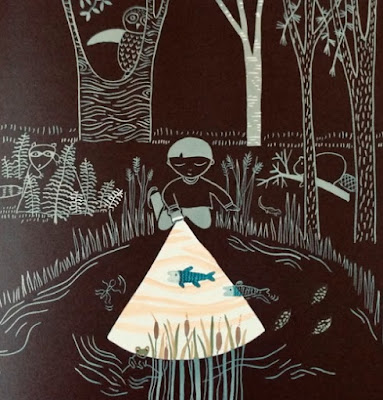Flashlight by Lizi Boyd is a wordless book about a child who goes
camping, wanders around in the dark, and gets lost. Oh no! How
will the child get back to the tent? Keep reading to find out what
happens to the child, to learn more about Flashlight and the importance
of wordless books, and to find the directions for a fun, book-inspired art
activity!


🍎 character: a child, forest animals
🍎 setting: outside, in the forest, at night


Disclosure:
Affiliate links
to Amazon are included in this post.
Author's Summary
Inside the tent it's cozy, but what is going on outside? Is it dark? Is it scary? Not if you have your trusty flashlight! A charming story told solely through images: Through neatly drawn illustrations and a spare yet dramatic color palette, artist Lizi Boyd offers an enchanting exploration of night, nature, and art with Flashlight. Both lyrical and humorous, this visual poem—like the flashlight beam itself—reveals there is magic in the darkness. We just have to look for it.
🍎
Title:
Flashlight
🍎 Author: Lizi Boyd
🍎 Illustrator: Lizi Boyd
🍎 Publisher: Chronicle Books
🍎 Date: August 12, 2014
🍎 Pages: 40
🍎 Illustrator: Lizi Boyd
🍎 Publisher: Chronicle Books
🍎 Date: August 12, 2014
🍎 Pages: 40

About Wordless Books
Wordless books are often overlooked as a valuable teaching resource.
Since they have no words in them, they tend get labeled as 'too easy' or
as 'baby books.' Wordless books, however, reinforce some critical
reading skills:
- Wordless books help improve children's confidence and independence while reading.
- Children have an opportunity to use their imaginations and practice their inferential skills while reading wordless books.
- Wordless books reinforce verbal skills by encouraging children to talk about the illustrations, ask and answer questions about the story, and retell the story in their own words.
- When children have a chance to talk about wordless books with other people, it helps with vocabulary acquisition.
- Children learn the importance of illustrations in wordless books... illustrations show us what's happening in the story and are more than decorations.
- While children read wordless books, they learn about story plots and structure.
- Wordless books can be a source of inspiration for creative writing and writing skills.

Story Elements
All good children's books... including wordless books... have characters,
settings, problems, and solutions. As you look through the pages of
Flashlight with your students, talk with them about what they see
happening on each page. Who is the main character? What is the
main character doing? What is the main character looking at?
What is the biggest problem of the story? What is its solution?
🍎 character: a child, forest animals
🍎 setting: outside, in the forest, at night
🍎 problem: A child is walking alone in
the forest at night. The child drops the flashlight and gets lost.
🍎 solution: The forest animals find the
flashlight and light the way back to the child's tent.

Enrichment Art Activity
As you read and discuss Flashlight, take some time to analyze the
illustrations. Lizi Boyd painted her illustrations with gouache
paint on a black background. Talk about how this gives us the
feeling of night and not being able to see well in the dark. In each
illustration, the child shines the flashlight on something and we can see
that thing in full detail. After reading Flashlight, children
can create their own nighttime drawing inspired by the illustrations in
the book!
You Will Need
- black drawing paper
- paint or gel pens, etc. (Lizi Boyd used a special kind of watercolor called 'gouache.')
- white triangles of various sizes
- white glue
Directions
These are the directions for recreating simplified versions of
the illustrations in Flashlight. Instead of using gouache
paints like Lizi Boyd, we opted for gel pens. Using the gel pens
created similar... but not exact... impressions and
was less expensive than gouache paints. Feel free to substitute
drawing or painting materials as needed.
- Draw a nighttime scene with the main character holding a flashlight. (For fun, children can draw themselves instead of the main character... totally up to you!)
- Take one of the white triangles and glue it to the end of the flashlight. Cut and resize the triangle as needed. It's OK if the triangle covers parts of the drawing.
- Using pens, markers, pencils, etc., recreate the 'missing parts' of the drawing.

To learn more about Flashlight by Lizi Boyd, check out this
interview with
Picture Book Storymakers in which Lizi Boyd describes her inspiration for Flashlight and
how she created its illustrations. You can also read the story on
YouTube. Chronicle Books put together a really nice video to
preview the book.
Did you enjoy reading about Flashlight and the art activity? If so, check
out these blog posts about more children's books and crafts:
- Book + Craft: Lexi's Special Tooth Fairy Pillow by Ann Morris
- Book + Craft: Pete the Cat and the Treasure Map by James Dean
- Book + Craft: Lucy's Mask by Lisa Sirkis Thompson
- Book + Craft: Broccoli Rob and the Garden Singers by John S. Armstrong
- Book + Craft: Leaves in Fall by Mari Schuh
- Book + Craft: Zester the Zebra and His Missing Stripes by Christen Conrad
- Book + Craft: The Night Before St. Patrick's Day by Natasha Wing



No comments:
Post a Comment
Note: Only a member of this blog may post a comment.